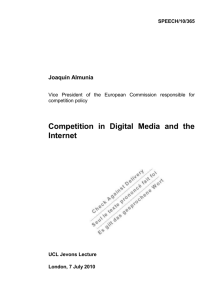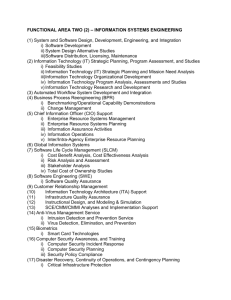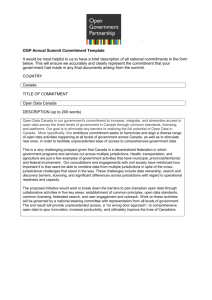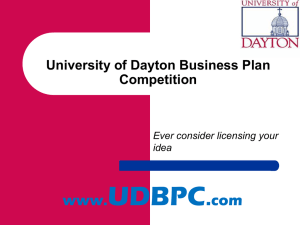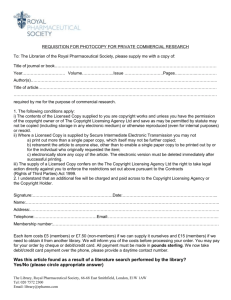Example 1 - Pakistan Telecommunication Authority
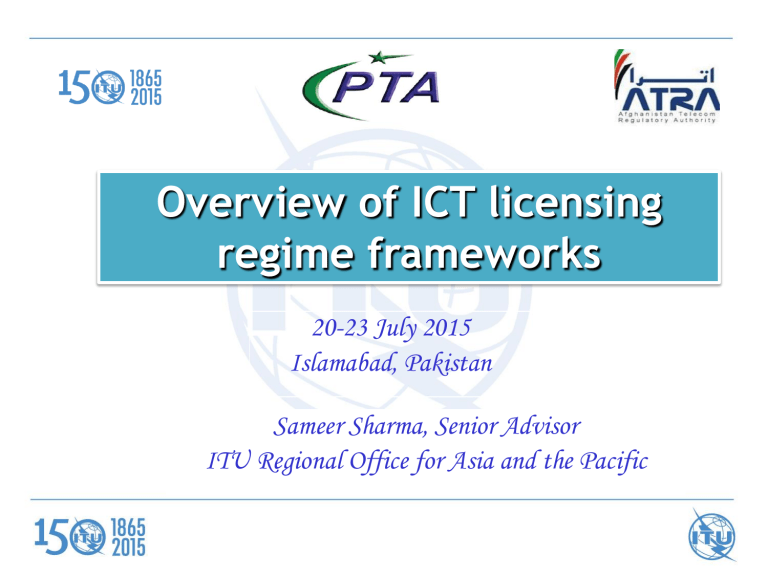
Overview of ICT licensing regime frameworks
20-23 July 2015
Islamabad, Pakistan
Sameer Sharma, Senior Advisor
ITU Regional Office for Asia and the Pacific
Agenda
ICT Development Trends
Regulatory Trends
Licensing Framework & Migration
International Best Practices
Conclusions
ITU: A Brief Overview
Founded in 1865
A specialized agency of the UN with focus on Telecommunication / ICTs
193
Member States
567
Sector Members
159
Associates
60
Academia
ITU-R : ITU’s Radio-communication Sector globally manages radio-frequency spectrum and satellite orbits that ensure safety of life on land, at sea and in the skies.
Headquartered in
Geneva,
4 Regional Offices
7 Area Offices.
ITU-T : ITU's Telecommunication Standardization Sector enables global communications by ensuring that countries’ ICT networks and devices are speaking the same language.
ITU-D : ITU’s Development Sector fosters international cooperation and solidarity in the delivery of technical assistance and in the creation, development and improvement of telecommunication/ICT equipment and networks in developing countries.
A Day in Digital World
ICT Services Uptake
Global, 2014
Mobile cellular subscriptions:
- Almost 7 billion
Mobile broadband penetration:
84% developed countries
21% developing countries
Fixed broadband penetration:
27.5 % developed countries
6 % developing countries
- Almost 3 billion people online
(individuals using the Internet)
Who’s online?
By region, 2014
Source: ITU World Telecommunication/ICT Indicators database
Broadband now affordable in 111 countries
MBB less expensive than FBB
3 G Mobile Broadband Coverage: Extending in Rural Areas
MDGs 2000-2015:
ICT Revolution and Remaining Gaps
Digital Divide in 2015
Mobile Broadband Subscribers % Individuals using Internet
Fixed BB across regions of the world
Fixed (wired) Broadband subscriptions per 100 inhabitants 2014*
Active users by social platform : Jan’ 2015
Regulatory Trends
Connect 2020 Agenda
For Global Telecommunication/ICT Development
Enable and foster access to and increased use of telecommunications/ICTs
Bridge the digital divide and provide broadband for all
Manage challenges resulting from telecommunication/ICT development
Lead, improve and adapt to the changing telecommunication/ICT environment www.itu.int/en/connect2020
ICT Market Trends
Challenges to Traditional Service Providers
Licensing Framework
Regulating Fixed Line Services
Regulating Mobile Services
Broadband Plans Financing Means
Broadband plans, 2014
45
40
35
30
25
20
15
10
5
0
Africa Arab States Asia &
Pacific
CIS Europe Americas plan adopted planning to adopt one
Source: ITU Telecommunications/ICT Regulatory Database
Over 140 governments worldwide have adopted a national broadband policy
Financing: Public-private partnerships and Government funding are the main means of financing broadband deployments in the region
1
9
What Are The Goals of the Broadband Plans?
Operational USO Funds
Operators/ service providers required to contribute to USF
Maturity of Regulation
Beginning of 2014
G4: Integrated regulation – led by economic and social policy
G3: Enabling investment, innovation and access – dual focus on stimulating competition in service and content delivery, and consumer protection
G2: Basic reform – partial liberalization and privatization across the layers
G1: Regulated public monopolies – command and control approach
Source: ITU.
Better Regulation – Greater Growth?
Evolution of mobile broadband penetration, by generation of regulation, 2009-
2013
Note: Based on data for 122 countries over the entire period.
Source: ITU.
Licensing Framework &
Migration
Changing Institutional Frameworks
Legislations embracing the power of convergence as well as addressing concerns such as
Cybersecurity on the rise.
Institutional convergence including Telecom, Broadcasting,
IT and in some cases even beyond on ground: e.g., Australia,
China, India, Republic of Korea,
Malaysia,
Converged policy & regulatory frameworks evolving: e.g., Converged
Licensing (Malaysia), Authorization
(European Union), Unified Access
License (India). Digital Signature, etc.
General Drivers of Migration
New services and revenue increase with multimedia services
– Compensate voice revenue reduction and increase
BB related business
– Providing Service innovation (e.g. VPN)
– Decreased time to market
Cost reductions by sharing network infrastructure and systems
– Savings are a function of network scenario, equipment modernization status and customers grow speed
– Evolving legacy networks to NGN: Reduced OPEX and streamline operations
Simplification of O&M
– Integrated operation platforms, maintenance and training
– Centralized Management and Control
New Services & NGN Applications
Drivers of Migration: Operators Perspective
• Business continuity required to maintain ongoing dominant services and customers that require carriergrade service
• Flexibility to incorporate existing new services and react quickly to the ones that appear on real time (main advantage of IP mode)
• Profitability to allow feasible return on investments and in the best practices market values
• Quality of Service to guarantee the Service Level
Agreements for different traffic mixes, conditions and overload.
• Interoperability across networks to allow to carry end to end services for flows in different network domains
Which licensing model to adopt?
•
Think long-term
•
Consider the administrative burden
•
Mix and match
– Different arrangements for different segments
•
Consider what terminology will be used
Individual licence
• Individually approved
• Specific rights and obligations
Class licence
• General system of rights and obligations
• Simple award process
Registration
• A formality
Notification
• File notification then commence
• No need to wait for approval
Open entry
• Not regulated
What Could be the Licensing Models?
Simplification of Licenses
Models for Reduction of Administrative Requirements
Source: Report from ITU-D Study Group 1, Question 10-2/1
Key issues in license migration
Differences in license fees (one time & annual)
Differences in the level of rights : Service scope, Spectrum,
Numbering, Right of way. License period, Service area etc.
Differences in the level of obligations : USO, Roll out,
Emergency services etc.
Others: impact on competition rules, interconnection etc.
Regulatory Instruments
Policy
Legislation
Regulation
License
Whether to regulate?
What to regulate?
Choice between commercial negotiation and regulation
How to regulate?
Choice between the level of detail to be inserted in each of these instruments
More flexible frameworks to enhance access
Simplification of licenses
Lowering the entry barriers (including administrative and procedural) to promote competition
Move towards service and technology neutrality
Principles to consider in migration
Fostering technology neutrality;
Ensuring flexibility to allow the new licensing regime to accommodate future technological and market changes;
Simplifying the number of license categories ;
Reducing administrative burdens and fees on market players;
Applying incentive mechanisms that encourage existing operators to transition to the converged licensing framework;
Ensuring transparency with regard to converged licensing responsibilities;
Fostering close collaboration amongst appropriate entities;
Source: Draft Report ITU-D Question 10-2/1:
Regulation for licensing and authorization of converging services
International Best Practices
2015 Survey on the National Broadband Policy/Plan
[Description of the survey]
• In June 2015, ITU conducted a survey on the latest progress on implementing broadband policy/plans
- 15 selected countries which requested the ITU assistance on national broadband policy/plans or recently updated the policy including,
- Bangladesh, Bhutan, Brunei Darussalam, Cambodia, Fiji, Indonesia, Lao
PDR, Myanmar, Nepal, Pakistan, Philippines, Vanuatu
(Papua New Guineas, Samoa, Vietnam)
2015 NBP Survey: Improving Licensing Regime
• In the last three years, many countries reported to have made considerable progress in reviewing or simplifying the licensing regime based on convergence
- High progress: Brunei Darussalam, Fiji, Indonesia, Vanuatu
- Some progress: Cambodia, Nepal, Lao PRD
- No or Low change: Bangladesh, Bhutan, Pakistan, Philippines
5
High
Progress
4
Review of current licensing regime
Average
3
2
Simplifying licensing based on convergence
No
Change
1
2015 NBP Survey: Spectrum allocation
• Most countries (except Nepal and Lao PDR) reported to have made good progress in improving spectrum efficiency in the last three years
• These countries also made some progress in adopting market-based approaches to spectrum allocation such as auction or beauty contest
5
High
Progress 4
Average
3
2
Improving spectrum efficiency
Introducing marketbased approach to spectrum allocation
No
Change
1
2015 NBP Survey: Licensing Practices
• Currently, variations exist in licensing practices between different countries
- Brunei, Myanmar, Pakistan and Philippines have taken a more flexible and dynamic
approach to spectrum/licensing management that can easily accommodate convergence
- Bhutan, Cambodia and Lao PRD still maintain a relatively rigid spectrum/licensing practices
Unified Licensing
Spectrum Allocation by Auction
Spectrum Allocation by Beauty Contest
Spectrum sharing
Secondary Trading of
Spectrum
In-band Migration
Bangla desh
Bhutan Brunei
D.
Camb odia
Fiji Indon esia
Lao
PRD
Myan mar
Nepal Pakist an
Philip pines
Vanuatu
2015 NBP Survey: Infrastructure Sharing
• The majority of the studied countries (except Nepal and Philippines) worked hard on establishing or enforcing infrastructure sharing rules on the licensees
5
High
Progress
4
Average
3
No
Change
2
1
Developing or enforcing infrastructure sharing rules
2015 NBP Survey: Consumer rights and QoS
• Regarding consumer rights and broadband quality of services, there exist considerable variations in the degree of progress made by each country
- High progress: Brunei, Cambodia, Pakistan, Vanuatu
- Low progress: Bangladesh, Bhutan, Fiji, Nepal, Philippines
5
High
Progress
4
No
Change
Average
3
2
1
Protecting consumer rights and broadband quality of service
Example 1: General authorization in the
European Union
• A general authorization instead of individual licenses . All electronic communication services and networks will be covered under a general authorization regime, with individual rights-of-use being confined to the assignment of radio frequencies and numbers only.
• A maximum set of conditions to be attached to general authorizations .
The Directive introduces a strict separation between:
(a) conditions under general law, applicable to all undertakings in all economic sectors;
(b) conditions under the general authorization applicable to all telecommunication services and networks; and
(c) conditions attached to rights of use for radio frequencies and numbers.
Example 2: Multi-service authorization in
Singapore
Facilities-based operator. (FBO) licenses
In general, operators that install or operate any kind of network infrastructure require an FBO license. This includes international and domestic wireless transmission or switching facilities; public cellular mobile networks; paging networks; public mobile data and trunked radio services; and local multipoint distribution services. Wireless services are licensed separately, pursuant to spectrum-management policies .
Service-based operator (SBO) licenses
Individual SBO licenses are required for international simple resale; resale of leased circuits; virtual private network services; managed data network services; Internet access; Internet exchange services; mobile virtual networks; and live audio-text services.
SBO class licenses cover simple resale of public switched telephony; international call-back services; Internet-based voice or data services; and international calling card services. Class licensees may offer their services without obtaining a specific authorization, but they are subject to all relevant codes of practice and service-quality standards.
Source: IDA ( http://www.ida.gov.sg/ ) Trends in Telecommunication Reform 2004/05
Example 3: Multi-service authorizations in Malaysia
• Network Facility Providers (NFPs), which include owners of satellite earth stations, fibre optic cables, communications lines and exchanges, radio communication and transmission equipment, mobile communication base stations and broadcasting towers and equipment;
• Network Service Providers (NSPs) for entities that provide basic connectivity and bandwidth to support a variety of applications;
• Application Service Providers (ASPs) for licensees that provide particular functions such as voice services, data services, Internet access services, IP telephony and other transmission services; and
• Content Applications Service Providers (CASPs) : A special subset of applications service providers . including traditional broadcast services and services such as online publishing and information services.
The services falling under these categories are further subdivided into individual, class and exempt services. A total of 56 categories of licensed services and 24 categories of licensed facilities were reorganized into the four generic licensing classifications established by CMA.
Source: MCMC (http://www.mcmc.gov.my/).
Example 4: Unified access service licensing in India
In October 2003, India adopted an Universal Access Service Licensing
(UASL) regime:
• Technology and Service Neutral Regime;
• Long distance, Internet Services etc. licensed separately
• Within a service area, license does not distinguish between types of access e.g. fixed, mobile, WLL;
• Basic Service operators had to pay a fees to enter UASL at benchmarked levels of fees paid by cellular mobile operators;
• Licenses to be allocated on first cum first served basis;
• 2G mobile spectrum (limited quantity) still a part of the license;
• 3G mobile spectrum auctioned separately.
A migration process
Understand framework
How will the new licensing framework be implemented?
Migration period
Will the transition be quick or gradual?
Licence mapping
To which licences will existing licences be migrated ?
Migration process
Are incentives needed?
What licensing rules are needed for implementation?
Is compensation necessary?
Are the migration rights clear and agreed?
What will happen to the existing licence conditions?
Who will administer licensing and manage migration?
What happens on the expiry of existing licences?
Is the migration process clear and publicised?
Is the administrative burden reasonable?
What other regulatory instruments are needed?
What opportunity will stakeholders have to comment?
How will licence fees be managed during transition period?
GSR 2009 and 2007 Best Practice
Guidelines
2009 In order to stimulate investment to grow converged markets, regulators need to further:
Build an adaptive regulatory framework by adopting a technology neutral approach, administratively simplified and flexible licensing regime providing for easy market entry of new players, such as through general authorizations and multiservice/unified licences.
2007 Authorization: We encourage regulators to simplify procedural requirements to obtain a license by introducing registrations, notifications, and in certain instances, deregulation and to secure rights of way in order to facilitate the roll-out of NGN access networks. This will ultimately allow market players to make use of NGN to access global markets and consumers to benefit from such global competition in the provision of services.
Conclusions
ICT development is taking at phenomenal pace posing challenge to conventional ways of regulation
Regulatory Authorities need to be agile and to be an agent of change to create proactive enabling environment
Technology / service neutral licensing regime based on convergence framework
License migration to converged approach is complex but essential requirement to fully harness the benefits in networked society
Building human and institutional capacity of regulatory agencies
ITU : I T hank U
ITU Publications
ITU-D Study Group 1 QUESTION 10-2/1:
Regulation for licensing and authorization of converging services http://www.itu.int/pub/D-STG-SG01.10.2-2010
Trends in Telecommunication Reform 2004/05 provides a comprehensive overview on licensing in an era of convergence.
http://www.itu.int/pub/D-REG-TTR.7-2004
ICT Regulation Toolkit Module on Authorisation of
Telecommunication/ICT Services
. http://www.ictregulationtoolkit.org/en/Section.507.html
.
